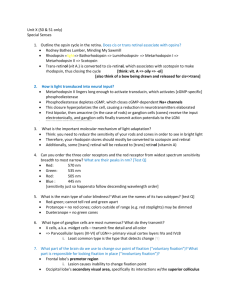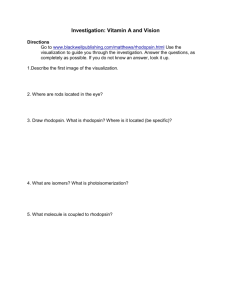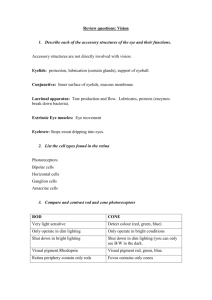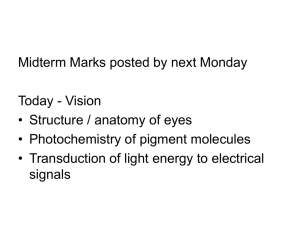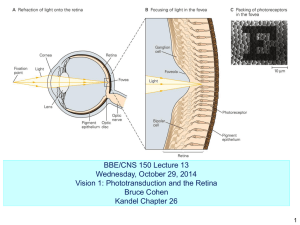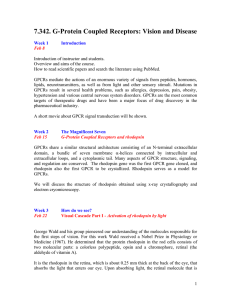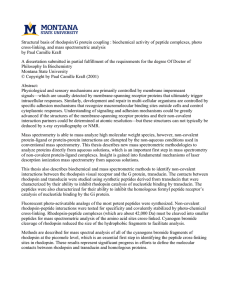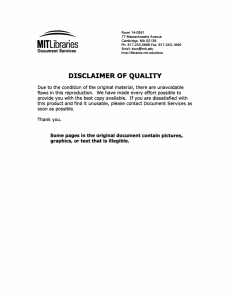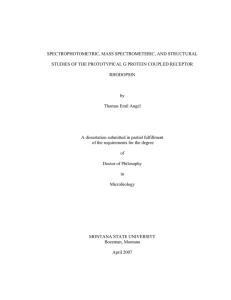Structure of Rod and cones cells in retins
advertisement
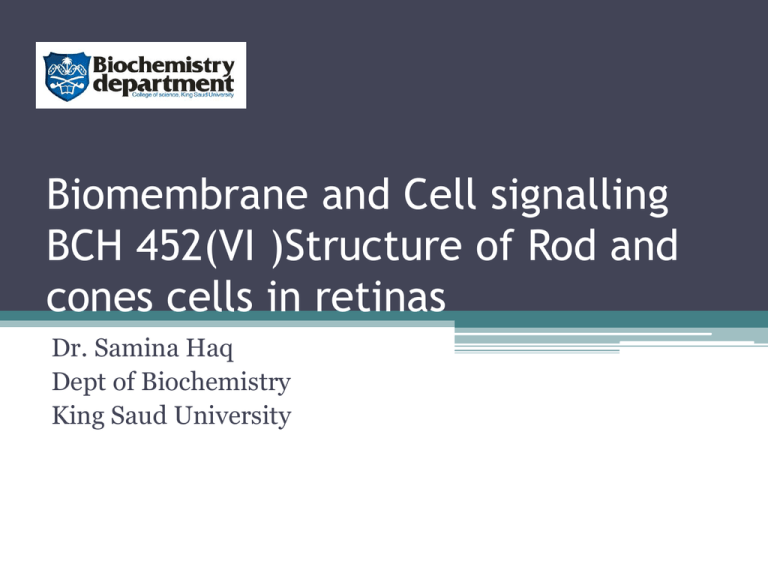
Biomembrane and Cell signalling BCH 452(VI )Structure of Rod and cones cells in retinas Dr. Samina Haq Dept of Biochemistry King Saud University Photoreceptors in eye • • • • Vision is based on the absorption of light by photoreceptors cells in the eye. These cells are sensitive to a narrow range of electromagnetic range of 300-850nm. Vertebrates have two types of photoreceptors cells Rods & Cones because of their distinctive structure. Human retina contains about 3 millions cones and about 100 millions rods. Rod Cells Rod Cells • They are cylindrical elongated structure whose outer segment is specialized for photoreceptors. It contains a stack of about 100 discs which are membrane enclosed sacs densely packed with photoreceptors molecules. The photoreceptors molecules are called Visual pigment as it has the ability to absorb light. • The photoreceptors molecule in rods are called rhodopsin Which consist of protein called opsin linked to 11-cis-retinol a prosthetic group. Rhodopsin • It absorb high percentage of photons that strike it. • The colour of rhodopsin and its resposiveness to light depends on the presence of light absorbing gps(chromophore) 11-cis retinol.This compound is a powerful absorber of light because of polyene with alternating single and double bond Structure. Isomerization of 11-cis retinol • Light absorbtion results inisomerization of 11cis-retinol to all trans form. • The isomerization causes Schiff’s base nitrogen atom to move approx 5Aassuming that the cyclohexane ring of the retinol group remain fixed. The light energy of photon is converted into atomic motion. The change in atomic position like the binding of ligand to ather 7TM receptors lead to a train off events that leads to closing of ion channels and the generation of nerve impulse. The isomerization of the retinal Schiff base • takes place within a few picoseconds of a photon being absorbed. The initial product, termed bathorhodopsin, contains a strained all-transretinal group. Within approximately 1 millisecond, this intermediate is converted through several additional intermediates into metarhodopsin II. In metarhodopsin II, the Schiff base is deprotonated and the opsin protein has undergone significant reorganization. • Retinal-Lysine Linkage. Retinal is linked to lysine 296 in opsin by a Schiff-base linkage. In the resting state of rhodopsin, this Schiff base is protonated. Bathorhodopsin (n-Sec) Light Energy P sec ▫ Rhodopsin Lumirhodopsin (µ-Sec) Min Metarhodopsin I (m-sec) Opsin Metarhodopsin II (sec) All-trans-retinal 11-cis-Retinal Isomerase 11-cis-Retinol Isomerase All-trans-retinol (Vitamin A ) The Role of Vitamin A in the formation of Rhodopsin • Vitamin a is present both in the cytoplasm of the rods and in the pigment layer of the retina as well. So it is always available to form new retinal when needed. Night blindness occurs in severe vitamin A deficiency. • Metarhodopsin II (also referred to as R*) is analogous to the ligand-bound state of 7TM receptors such as the b 2-adrenergic receptor and the odorant and tastant receptors. • Like these receptors, this form of rhodopsin activates a heterotrimeric G protein that propagates the signal. The G protein associated with rhodopsin is called transducin. Metarhodopsin II triggers the exchange of GDP for GTP by the a subunit of transducin . • On the binding of GTP, the β גsubunits of transducin are released and the a subunit switches on a cGMP phosphodiesterase by binding to and removing an inhibitory subunit. • The activated phosphodiesterase is a potent enzyme that rapidly hydrolyzes cGMP to GMP. The reduction in cGMP concentration causes cGMP-gated ion channels to close, leading to hyperpolarization of the membrane and neuronal signaling. • At each step in this process, the initial signal the absorption of a single photon is amplified so that it leads to sufficient membrane hyperpolarization to result in signaling. The conversion of rhodopsin into metarhodopsin II activates a signaltransduction pathway analogously to the activation induced by the binding of other 7TM receptors to appropriate ligands • the visual system responds to changes in light and color within a few milliseconds, quickly enough that we are able to perceive continuous motion at nearly 1000 frames per second. To achieve a rapid response, the signal must also be terminated rapidly and the system must be returned to its initial state. • First, activated rhodopsin must be blocked from continuing to activate transducin. Rhodopsin kinase catalyzes the phosphorylation of the carboxyl terminus of R* at multiple serine and threonine residues. Arrestin, an inhibitory protein. • Second, the a subunit of transducin must be returned to its inactive state to prevent further signaling. Like other G proteins, the a subunit possesses built-in GTPase activity that hydrolyzes bound GTP to GDP. Hydrolysis takes place in less than a second when transducin is bound to the phosphodiesterase. The GDP form of transducin then leaves the phosphodiesterase and reassociates with the β ג subunits, and the phosphodiesterase returns to its inactive state. • Third, the level of cGMP must be raised to reopen the cGMP-gated ion channels. The action of guanylate cyclase accomplishes this third step by synthesizing cGMP from GTP. Calcium ion plays an essential role • in controlling guanylate cyclase because it markedly inhibits the activity of the enzyme. In the dark, Ca2+ as well as Na+ enter the rod outer segment through the cGMP-gated channels. Calcium ion influx is balanced by its efflux through an exchanger, a transport system that uses the thermodynamically favorable flow of four Na+ ions into the cell and one K+ ion out of the cell to extrude one Ca2+ ion. After illumination, the entry of Ca2+ through the cGMP-gated channels stops, but its export through the exchanger continues. Thus, the cytosolic Ca2+ level drops from 500 nM to 50 nM after illumination. This drop markedly stimulates guanylate cyclase, rapidly restoring the concentration of cGMP to reopen the cGMP-gated channels. In human Cone cells there are 3 distinctive photoreceptors proteins with absorption maximum at 426,530,560 as blue, green, red regions of spectrum. Colour Vision is mediated by 3Cone receptors Cells • Cone cells like rod cells contain visual pigament. Homologue of rhodopsin these photoreceptors proteins are member of the 7TM receptors family and utilizes 11-cis-retinol as their chromosphores. There is striking similarities in amino acid homology in rhodopsin and cone photoreceptors.
